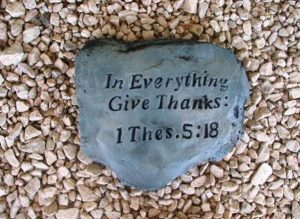We live most of our lives mindlessly. We may be doing one thing, but our minds tend to be on other things. We live in the present moment, but our minds are on the past or the future.
I first learned about the technique of “mindfulness” on a PBS television program, called “Healing and the Mind.” The host was the excellent reporter, Bill Moyers, and each episode featured a clinic, somewhere in the world, that specialized in mind/body medicine.
On this particular episode, he featured a clinic at Massachusetts Medical Center, a major teaching hospital where many Harvard medical students do their rotations and internships. People come there from all over the world for assessment and treatment of serious medical disorders.
In that hospital, is a clinic that was originally called “The Center for Catastrophic Illness,” and was founded by a psychologist, named Jon Kabit-Zinn. Patients are referred to this clinic who have any illness that has proven to be a catastrophe in their lives. The clinic has been enormously effective in helping these patients deal with their various illnesses.
The clinic teaches the technique of mindfulness. The technique has been practiced in Asia for about four thousand years, but has only been applied to healthcare in the US for about twenty years. While mindfulness practice cannot directly cure many physical illnesses, it can help patients deal with their difficulties with much less distress and discomfort. It has even been shown to cure some stress-related illnesses.
The technique involves three components, (a) noticing, (b) without judging, (c) in the present moment. To notice means to truly experience, to really be in the moment. Focus your attention on that event. Experience it with your five senses. If you are somewhere, really be there. Focus your mind on what you are doing, rather than something in the past or the future.
For example, if you are driving, notice the experience of driving. What do you see? What do you feel? Notice the unconscious movement of your hand on the steering wheel. Notice the subtle rumble of the road noise. Do the same with any experience. If you are interacting with a loved one, really focus your attention on that person and the interaction. If you are washing dishes, notice the various aspects of the experience, the feel of the water, the feel of the soap or the movements of your hands.
Now, try to recall some of the favorite moments of your life. I would bet that you experienced each of these favorite moments mindfully. You were focused on what you were doing at the time. If you experienced the moment mindlessly, you wouldn’t recall it as a favorite moment. I wonder how many other moments could have been favorites, if we had experienced them mindfully rather than mindlessly.
The second part of mindfulness is to notice “without judging.” This means to not analyze our experience in our minds, but to just experience it. We don’t focus on whether the experience is good or bad. It just is. For example, patients are actually taught to be mindful of their pain. This may seem strange, but we find that, when patients notice pain, without thinking of it as good or bad, the pain lessons, or at least becomes less distressful. We usually try to escape from our pain, and in doing so, make ourselves more tense. This tension actually worsens the discomfort.
The last part of mindfulness is “in the present moment.” This means to focus your attention on the present moment, rather than experiencing the present moment with your mind thinking about something in the past or something in the future.
Let’s think about time for a moment. All time can be divided into three parts; the past, the future, and the present. Everything prior to this moment in time is the past. Nothing in the past actually exists, except in our memories. Everything after this moment is the future, and nothing in the future actually exists except in our imaginations. The only thing that actually exists at any moment is that thin slice of time we call the present.
Yet, we live most of our present moments thinking about something in the past or something in the future. We don’t really experience the present moment, because we are analyzing, reminiscing or regretting past events or anticipating, dreading or worrying about future events. We thus miss the experience of the present moment.
Take a moment now to be mindful of the present moment. Notice what your five senses are experiencing. Notice your breathing. The act of noticing the breath can always bring you back to the present moment. Your breath is always with you. Let yourself simply be in the present moment now and experiencing this moment fully. If your mind wanders to the past or the future, it’s okay. Just gently bring your attention back to your breath and the present moment.
Practice this for a few moments at a time. If you can stay in the present moment for a few seconds, that’s good enough at first. After being mindful of the present moment experience for a little while, notice what you feel. Most people report that they feel a sense of calm or peace.
Practice mindfulness several times per day. You don’t have to take time out of your day at first. Just be mindful of whatever you’re doing. Then, if you like, take a few moments out of your day to get in a more extended time of present moment awareness. Give it a try!
Question: If you have tried present-moment mindfulness, what did you experience? Also, report any difficulties you experienced in trying the technique.





